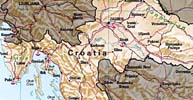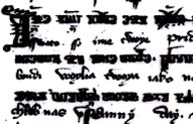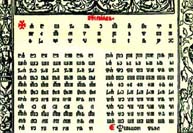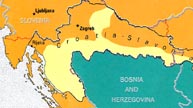TITLE PAGE
GLAGOLITIC PAST
1483 MISSAL
BIBLIOGRAPHY
The relief map of Republic of Croatia. The image from University of Texas PCL map collection.
Alphabet and Pater noster written in Glagolitic and Latin script from manuscript of Jurij of Slavonija, 14th-15th century. (Čunčić 2003, p. 20)
The first Glagolitic primer, printed 1527 in print shop of Andrea Torresani, Venice. The image from web page "Croatian Glagolitic Manuscripts held outside of Croatia"
The historical map of territory of Croatia, early 19th century. The image from University of Texas PCL map collection.
INTRODUCTION
The territory of CROATIA was populated by its current population during the 5th to 7th centuries, in one of the last waves of population movement that changed the demographic structure of Europe. Because of the nature of its geography, from the beginning the country was politically divided in a northern part (Pannonian Croatia) and a southern, coastal region (Dalmatian Croatia). The territory was for centuries the conflict point of competing nobilities (Franks vs. Slavs vs. Magyar), competing churches (Rome vs. Constantinople), and competing heritages (Holy Roman Empire vs. Byzantium).
The ADRIATIC COAST (Dalmatia) is separated from the inland by a chain of limestone mountains, and the region was from ancient times part of Mediterranean civilization. The population of coastal towns remained for centuries, after Slavic settlement of the surrounding countryside, staunchly Roman and heavily influenced by Italian culture. The most important player in Dalmatian region was the VENETIAN REPUBLIC, which continuously aspired to gain complete control of the Adriatic Sea. Only the REPUBLIC OF DUBROVNIK (Ragusa) managed to develop into a significant political and mercantile force.
The legacies of the power struggle between Rome and Constantinople were the CYRILLIC script and the use of the old Slavic language in the liturgy of the Orthodox Churches. In the year 862, Prince Rostislav of Great MORAVIA (846-870) requested that Constantinople, rather than Rome, send missionaries to help the Christianization of Slavs. To facilitate that mission, brothers Cyril (827-869) and Methodius (825-884) also known as APOSTLES OF SLAVS, using the Greek script as a model, developed the Cyrillic script for Slavic languages.
Sometimes in the 9th century GLAGOLITIC (glagoljica) script (more details in THE GLAGOLITIC SCRIPT), start to spread in the territories of the Balkan Peninsula. While Cyrillic was used in the scriptures of the Orthodox liturgy, Glagolitic was used for the scriptures in the Roman Catholic liturgy. In the 10th century, Slavic languages and use of the Glagolitic scriptures in Roman Churches was officially forbidden but the practice persisted because of a lack of clergy with sufficient knowledge of Latin. Silent support of the local (Croatian) nobility and obscurity of the region facilitated preservation of the script. Finally, in the year 1248, the Pope Innocent IV (d. 1254) gave a special permission for the use of Croatian language and script in the liturgy.
With the onset of the printing, the Glagolitic church was very quick to realize the advantage of the new invention. The editio princeps of Glagolitic missal appears in the 1483 and of Glagolitic breviary in the 1491, however we do not know printer, publisher, or place where these books were printed. A few years later the Glagolitic bishopy of Senj send the priest Blaž Baromić to Venice to learn printing, so that he will be able later to organize a print shop back home. The print shop in Senj operated between 1494 and 1508 and published eight books. Between 1530 and 1531, bishop Šimun Kožičić Benja organized a print shop in Rijeka, publishing five glagolitic books.
In the year 1493, the Croatian nobility lost the battle against the Ottoman Turks at the fields of Krbava, which enabled advancement of the OTTOMAN EMPIRE throughout most of continental Croatia. Although this territory never came under the permanent Ottoman control, all this regions become kraijna—the borderland of constant skirmishes and raids—which induced numerous population shifts, destroyed the economic base, and stalled all cultural flows in the continental part of the country.
After the end of the operation of the print shop in Rijeka, the sporadic printing of Glagolitic books continued in Venice. There were produced some of the most beautifully designed Glagolitic books, like Glagolitic primer from 1527, for example. During the 16th century, there were only two other print shops in Croatia, both in the north, at the border with Austria, in towns of NEDELIŠĆE (1574) and VARAŽDIN (1586). These workshops printed books in the Croatian language (northern dialect) in Latin script. Until the 18th century, all books in Croatian were printed in foreign printing houses. On the territories controlled by Venice (islands and the Istrian peninsula), any establishment of printing workshops was discouraged if not outright forbidden, so they would not compete with the Venetian printing industry. In the Republic of Dubrovnik, where an Italian-style renaissance flourished, they found out that it is much more economic to order books to be printed abroad than to organize the whole enterprise at home.
More details about the HISTORY OF CROATIA
in article
by Dragutin Pavličević.
Written by Vlasta Radan.
Last update April 10, 2006.



